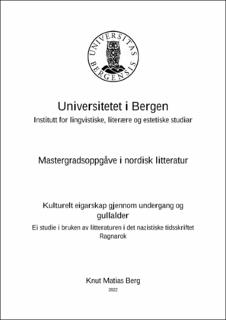| dc.description.abstract | Denne masteroppgåva er ei litterær studie i det nazistiske tidsskriftet Ragnarok som kom ut i perioden 1935 til 1945. Fleire av bidragsytarane bak tidsskriftet hadde vore medlem av Nasjonal Samling, men meldte seg ut i protest mot at partiet ikkje hadde nok fokus på blant anna rase. Tidsskriftet oppstod som ein protest mot leiinga og den ideologiske retninga i Nasjonal Samling, men mest av alt var Ragnarok eit talerøyr for norske og internasjonale nazistar. Som med nazismen generelt var Ragnarok djupt rasistisk, kvinnefiendtleg, homofobisk, konspiratorisk, antidemokratisk, antisemittisk og imperialistisk. Ragnarok kan karakteriserast som eit allmennkulturelt tidsskrift. I Ragnarok blei det drøfta kulturelle, sosiale, økonomiske, politiske, religiøse og vitskaplege saker, både aktuelle og eldre. Tidsskriftet trykka artiklar, lesarinnlegg, kåseri, brev frå fronten (under krigen), biografiar og karikaturar (ofte rasistiske). I tillegg hadde tidsskriftet ei fast spalte som omtalte bøker, samt at det ofte blei trykka analysar av litteratur og andre kunstnariske uttrykk – både av faste spaltistar og eingongsinnsendarar. Artiklane og innlegga kunne handle om det aller meste, og spegla ofte samtida rundt seg. Det som karakteriserer tidsskriftet er den store og utstrekte bruken av litteraturen – både samtidig og eldre. Litteraturen blei bevisst brukt for å skape eit narrativ omkring det autentiske norske, ta eigarskap over kulturen, peike ut fiendar, hindre sjølverklært undergang og skildre gullalderen som skulle kome. | |
| dc.description.abstract | This master’s thesis is a literary study of the Nazi journal Ragnarok, which was published between 1935 and 1945. Several the contributors behind the journal had been members of the Norwegian fascist party “Nasjonal Samling”, but resigned from the party on the grounds of it not having sufficient focus on race, amongst other things. The journal was founded as a protest against the party’s leadership and ideological direction, but mainly it was, and became, a mouthpiece for Norwegian and international Nazis. Ragnarok followed the prevailing Nazi views, and was deeply racist, misogynistic, homophobic, conspiratorial, antidemocratic, anti-Semitic, and imperialistic. Furthermore, Ragnarok can be characterized as a general cultural journal. Within its pages, cultural, social, economic, politic, religious, and scientific issues, and topics, were discussed – both current and past. Ragnarok printed and published articles, letters to the editor, causeries, letters from the front (during the war), biographies, and caricatures (that often were racist). What’s more, the journal held a regular column which reviewed books. In addition to this, analyses and studies of literature, and other artistic expressions, were printed throughout its lifespan, both by recurring and occasional writers. The articles and posts could relate to most events, and often emulated the v general society. That which characterises Ragnarok is the widespread use of literature, which includes ancient, medieval, early modern, and (the journals own) contemporary literature. The use of literature was intentional, and it was utilised to create a narrative around the authentic Norwegian, take ownership over the culture, point out enemies, prevent the selfproclaimed doom, and usher in the coming golden age | |
